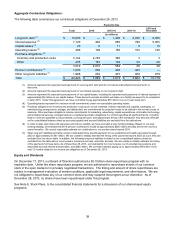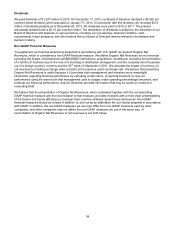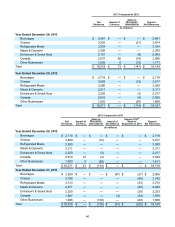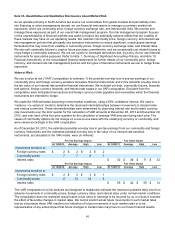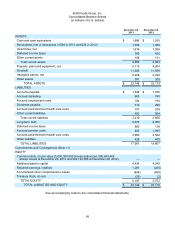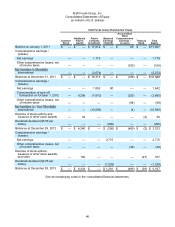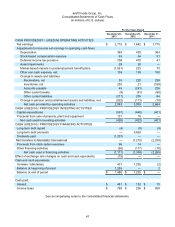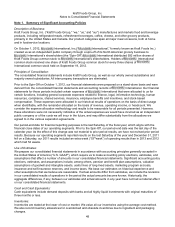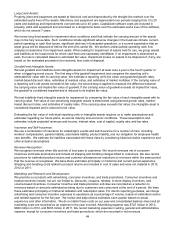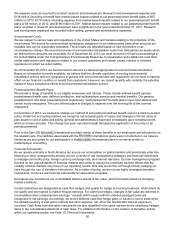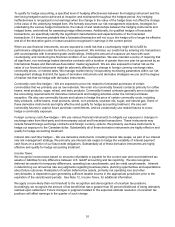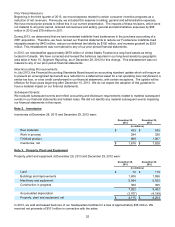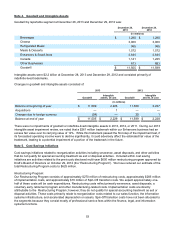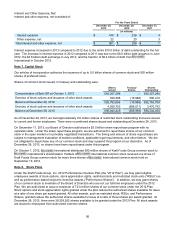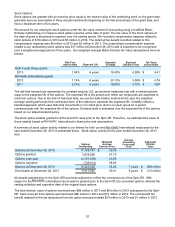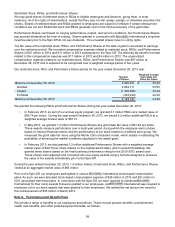Kraft 2013 Annual Report Download - page 50
Download and view the complete annual report
Please find page 50 of the 2013 Kraft annual report below. You can navigate through the pages in the report by either clicking on the pages listed below, or by using the keyword search tool below to find specific information within the annual report.
48
Kraft Foods Group, Inc.
Notes to Consolidated Financial Statements
Note 1. Summary of Significant Accounting Policies
Description of Business:
Kraft Foods Group, Inc. (“Kraft Foods Group,” “we,” “us,” and “our”) manufactures and markets food and beverage
products, including refrigerated meals, refreshment beverages, coffee, cheese, and other grocery products,
primarily in the United States and Canada. Our product categories span all major meal occasions, both at home
and in foodservice locations.
On October 1, 2012, International, Inc. International,” formerly known as Kraft Foods Inc.)
created us as an independent public company through a spin-off of its North American grocery business to
International’s shareholders (the “Spin-Off”). International distributed 592 million shares of
Kraft Foods Group common stock to International’s shareholders. Holders of International
common stock received one share of Kraft Foods Group common stock for every three shares of
International common stock held on September 19, 2012.
Principles of Consolidation:
The consolidated financial statements include Kraft Foods Group, as well as our wholly owned subsidiaries and
majority owned subsidiaries. All intercompany transactions are eliminated.
Prior to the Spin-Off on October 1, 2012, our financial statements were prepared on a stand-alone basis and were
derived from the consolidated financial statements and accounting records of International. Our financial
statements for those periods included certain expenses of International that were allocated to us for
certain functions, including general corporate expenses related to finance, legal, information technology, human
resources, compliance, shared services, insurance, employee benefits and incentives, and stock-based
compensation. These expenses were allocated in our historical results of operations on the basis of direct usage
when identifiable, with the remainder allocated on the basis of revenue, operating income, or headcount. We
consider the expense allocation methodology and results to be reasonable for all periods presented. However,
these allocations were not necessarily indicative of the actual expenses we would have incurred as an independent
public company or of the costs we will incur in the future, and may differ substantially from the allocations we
agreed to in the various separation agreements.
Our period-end date for financial reporting purposes is the last Saturday of the fiscal year, which aligns with the
financial close dates of our operating segments. Prior to the Spin-Off, our period-end date was the last day of the
calendar year. As the effect of this change was not material to prior period results, we have not revised prior period
results. Because our operating segments reported results on the last Saturday of the year and December 31, 2011
fell on a Saturday, our 2011 results included an extra week (“53rdweek”) of operating results than in 2013 and 2012
which had 52 weeks.
Use of Estimates:
We prepare our consolidated financial statements in accordance with accounting principles generally accepted in
the United States of America (“U.S. GAAP”), which require us to make accounting policy elections, estimates, and
assumptions that affect a number of amounts in our consolidated financial statements. Significant accounting policy
elections, estimates, and assumptions include, among others, pension and benefit plan assumptions, valuation
assumptions of goodwill and intangible assets, useful lives of long-lived assets, marketing program accruals,
insurance and self-insurance reserves, and income taxes. We base our estimates on historical experience and
other assumptions that we believe are reasonable. If actual amounts differ from estimates, we include the revisions
in our consolidated results of operations in the period the actual amounts become known. Historically, the
aggregate differences, if any, between our estimates and actual amounts in any year have not had a material effect
on our consolidated financial statements.
Cash and Cash Equivalents:
Cash equivalents include demand deposits with banks and all highly liquid investments with original maturities of
three months or less.
Inventories:
Inventories are stated at the lower of cost or market. We value all our inventories using the average cost method.
We also record inventory allowances for overstocked and obsolete inventories due to ingredient and packaging
changes.


